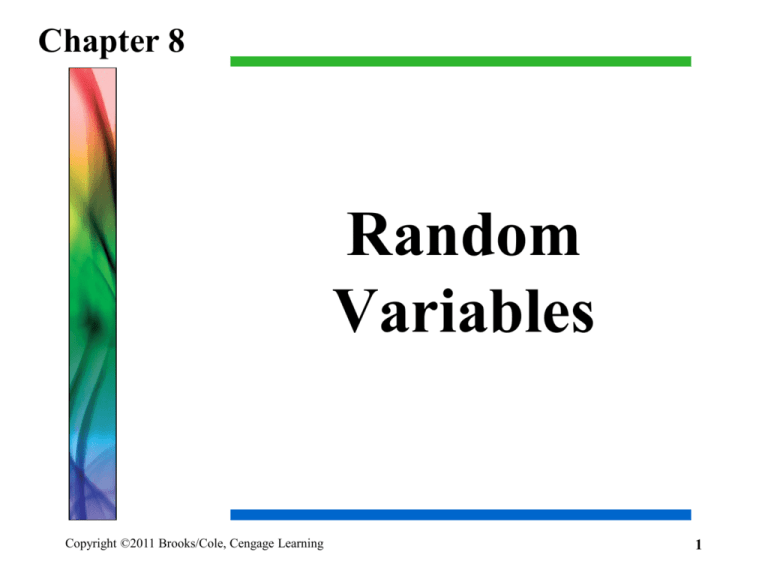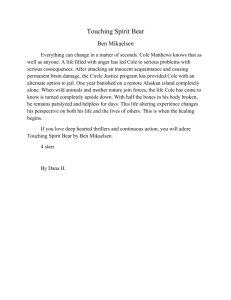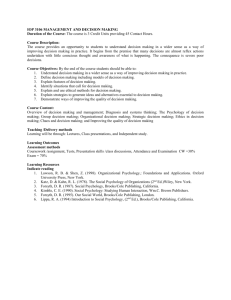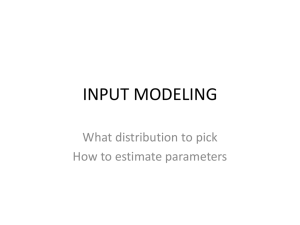Document
advertisement

Chapter 8 Random Variables Copyright ©2011 Brooks/Cole, Cengage Learning 1 8.1 What is a Random Variable? Random Variable: assigns a number to each outcome of a random circumstance, or, equivalently, to each unit in a population. Two different broad classes of random variables: 1. A discrete random variable can take one of a countable list of distinct values. 2. A continuous random variable can take any value in an interval or collection of intervals. Copyright ©2011 Brooks/Cole, Cengage Learning 2 Example 8.1 Random Variables at an Outdoor Graduation or Wedding Random factors that will determine how enjoyable the event is: Temperature: continuous random variable Number of airplanes that fly overhead: discrete random variable Copyright ©2011 Brooks/Cole, Cengage Learning 3 Example 8.2 Probability an Event Occurs Three Times in Three Tries • What is the probability that three tosses of a fair coin will result in three heads? • Assuming boys and girls are equally likely, what is the probability that 3 births will result in 3 girls? • Assuming probability is 1/2 that a randomly selected individual will be taller than median height of a population, what is the probability that 3 randomly selected individuals will all be taller than the median? Answer to all three questions = 1/8. Discrete Random Variable X = number of times the “outcome of interest” occurs in three independent tries. Copyright ©2011 Brooks/Cole, Cengage Learning 4 8.2 Discrete Random Variables X the random variable. k = a number the discrete r.v. could assume. P(X = k) is the probability that X equals k. Probability distribution function (pdf) X is a table or rule that assigns probabilities to possible values of X. Example 8.5 Number of Courses 35% of students taking four courses, 45% taking five, and remaining 20% are taking six courses. X = number of courses a randomly selected student is taking The probability distribution function of X can be given by: Copyright ©2011 Brooks/Cole, Cengage Learning 5 Conditions for Probabilities for Discrete Random Variables Condition 1 The sum of the probabilities over all possible values of a discrete random variable must equal 1. Condition 2 The probability of any specific outcome for a discrete random variable must be between 0 and 1. Copyright ©2011 Brooks/Cole, Cengage Learning 6 Probability Distribution of a Discrete R.V. Using the sample space to find probabilities: Step 1: List all simple events in sample space. Step 2: Identify the value of the random variable X for each simple event. Step 3: Find the probability for each simple event (often equally likely). Step 4: Find P(X = k) as the sum of the probabilities for all simple events where X = k. Probability distribution function (pdf) X is a table or rule that assigns probabilities to possible values of X. Copyright ©2011 Brooks/Cole, Cengage Learning 7 Example 8.6 PDF for Number of Girls Family has 3 children. Probability of a girl is ½. What are the probabilities of having 0, 1, 2, or 3 girls? Sample Space: For each birth, write either B or G. There are eight possible arrangements of B and G for three births. These are the simple events. Sample Space and Probabilities: The eight simple events are equally likely. Random Variable X: number of girls in three births. For each simple event, the value of X is the number of G’s listed. Copyright ©2011 Brooks/Cole, Cengage Learning 8 Example 8.6 & 8.7 Number of Girls Value of X for each simple event: Probability Distribution Function for Number of Girls X: Copyright ©2011 Brooks/Cole, Cengage Learning Graph of the pdf of X: 9 Cumulative Distribution Function of a Discrete Random Variable Cumulative distribution function (cdf) for a random variable X is a rule or table that provides the probabilities P(X ≤ k) for any real number k. Cumulative probability = probability that X is less than or equal to a particular value. Example 8.8 Cumulative Distribution Function for the Number of Girls Copyright ©2011 Brooks/Cole, Cengage Learning 10 Finding Probabilities for Complex Events Example 8.9 A Mixture of Children What is the probability that a family with 3 children will have at least one child of each sex? If X = Number of Girls then either family has one girl and two boys (X = 1) or two girls and one boy (X = 2). P(X = 1 or X = 2) = P(X = 1) + P(X = 2) = 3/8 + 3/8 = 6/8 = 3/4 pdf for Number of Girls X: Copyright ©2011 Brooks/Cole, Cengage Learning 11 8.3 Expectations for Random Variables The expected value of a random variable is the mean value of the variable X in the sample space or population of possible outcomes. Expected value = Sum of “value × probability” If X is a random variable with possible values x1, x2, x3, . . . , occurring with probabilities p1, p2, p3, . . . , then the expected value of X is calculated as E X xi pi Copyright ©2011 Brooks/Cole, Cengage Learning 12 Example 8.12 California Decco Lottery Player chooses one card from each of four suits. Winning card drawn from each suit. If one or more matches the winning cards prize. It costs $1.00 for each play. How much would you win/lose per ticket over long run? Lose an average of 35 cents per play. Copyright ©2011 Brooks/Cole, Cengage Learning 13 Standard Deviation for a Discrete Random Variable The standard deviation of a random variable is roughly the average distance the random variable falls from its mean, or expected value, over the long run. If X is a random variable with possible values x1, x2, x3, . . . , occurring with probabilities p1, p2, p3, . . . , and expected value E(X) = , then Variance of X V X 2 xi pi 2 Standard Deviation of X Copyright ©2011 Brooks/Cole, Cengage Learning 2 x pi i 14 Example 8.13 Stability or Excitement Two plans for investing $100 – which would you choose? Expected Value for each plan: Plan 1: E(X ) = $5,000(.001) + $1,000(.005) + $0(.994) = $10.00 Plan 2: E(Y ) = $20(.3) + $10(.2) + $4(.5) = $10.00 Copyright ©2011 Brooks/Cole, Cengage Learning 15 Example 8.13 Stability or Excitement Variability for each plan: Plan 1: V(X ) = $29,900.00 and = $172.92 Plan 2: V(X ) = $48.00 = $6.93 and The possible outcomes for Plan 1 are much more variable. If you wanted to invest cautiously, you would choose Plan 2, but if you wanted to have the chance to gain a large amount of money, you would choose Plan 1. Copyright ©2011 Brooks/Cole, Cengage Learning 16 Expected Value (Mean) and Standard Deviation for a Population Copyright ©2011 Brooks/Cole, Cengage Learning 17 8.4 Binomial Random Variables Class of discrete random variables = Binomial -- results from a binomial experiment. Conditions for a binomial experiment: 1. There are n “trials” where n is determined in advance and is not a random value. 2. Two possible outcomes on each trial, called “success” and “failure” and denoted S and F. 3. Outcomes are independent from one trial to the next. 4. Probability of a “success”, denoted by p, remains same from one trial to the next. Probability of “failure” is 1 – p. Copyright ©2011 Brooks/Cole, Cengage Learning 18 Examples of Binomial Random Variables A binomial random variable is defined as X=number of successes in the n trials of a binomial experiment. Copyright ©2011 Brooks/Cole, Cengage Learning 19 Finding Binomial Probabilities n! nk k P X k p 1 p for k = 0, 1, 2, …, n k!n k ! Example 8.15 Probability of Two Wins in Three Plays p = probability win = 0.2; plays of game are independent. X = number of wins in three plays. What is P(X = 2)? 3! 3 2 P X 2 .2 2 1 .2 2!3 2 ! 3(.2) 2 (.8)1 0.096 Copyright ©2011 Brooks/Cole, Cengage Learning 20 Expected Value and Standard Deviation for a Binomial Random Variable For a binomial random variable X based on n trials and success probability p, Mean E X np Standard deviation np1 p Copyright ©2011 Brooks/Cole, Cengage Learning 21 Example 8.18 Extraterrestrial Life? 50% of large population would say “yes” if asked, “Do you believe there is extraterrestrial life?” Sample of n = 100 is taken. X = number in the sample who say “yes” is approximately a binomial random variable. Mean E X 100(.5) 50 Standard deviation 100(.5).5 5 In repeated samples of n=100, on average 50 people would say “yes”. The amount by which that number would differ from sample to sample is about 5. Copyright ©2011 Brooks/Cole, Cengage Learning 22 8.5 Continuous Random Variables Continuous random variable: the outcome can be any value in an interval or collection of intervals. Probability density function for a continuous random variable X is a curve such that the area under the curve over an interval equals the probability that X is in that interval. P(a X b) = area under density curve over the interval between the values a and b. Copyright ©2011 Brooks/Cole, Cengage Learning 23 Example 8.19 Time Spent Waiting for Bus Bus arrives at stop every 10 minutes. Person arrives at stop at a random time, how long will s/he have to wait? X = waiting time until next bus arrives. X is a continuous random variable over 0 to 10 minutes. Note: Height is 0.10 so total area under the curve is (0.10)(10) = 1 This is an example of a Uniform random variable Copyright ©2011 Brooks/Cole, Cengage Learning 24 Example 8.20 Probability about Wait Time What is the probability the waiting time X is in the interval from 5 to 7 minutes? Probability = area under curve between 5 and 7 = (base)(height) = (2)(.1) = .2 Copyright ©2011 Brooks/Cole, Cengage Learning 25 8.6 Normal Random Variables Most commonly encountered type of continuous random variable is the normal random variable, which has a specific form of a bell-shaped probability density curve called a normal curve. A normal random variable is also said to have a normal distribution Any normal random variable can be completely characterized by its mean, , and standard deviation, . Copyright ©2011 Brooks/Cole, Cengage Learning 26 Example 8.21 College Women’s Heights Data suggest the distribution of heights of college women described well by a normal curve with mean = 65 inches and standard deviation = 2.7 inches. Note: Tick marks given at the mean and at 1, 2, 3 standard deviations above and below the mean. Empirical Rule are exact characteristics of a normal curve model. Copyright ©2011 Brooks/Cole, Cengage Learning 27 Useful Probability Relationships Copyright ©2011 Brooks/Cole, Cengage Learning 28 Useful Probability Relationships Copyright ©2011 Brooks/Cole, Cengage Learning 29 Example 8.22 Prob for Math SAT Scores Math SAT scores have a normal distribution with mean = 515 and standard deviation = 100. Q: Probability a score is less than or equal to 600? A: (using Minitab) .8023. Copyright ©2011 Brooks/Cole, Cengage Learning 30 Example 8.22 Prob for Math SAT Scores Math SAT scores have a normal distribution with mean = 515 and standard deviation = 100. Q: Probability a score is greater than 600? A: By complement, 1 – .8023 = .1977 Copyright ©2011 Brooks/Cole, Cengage Learning 31 Example 8.22 Prob for Math SAT Scores Math SAT scores have a normal distribution with mean = 515 and standard deviation = 100. Q: Probability a score is between 515 and 600? A: (since 50% of scores are larger than the mean of 515), .8023 – .5000 = .3023 Copyright ©2011 Brooks/Cole, Cengage Learning 32 Example 8.22 Prob for Math SAT Scores Math SAT scores have a normal distribution with mean = 515 and standard deviation = 100. Q: Probability a score is more than 85 points away from the mean in either direction? A: (since 600 is 85 points above the mean) .1977 + .1977 = .3954. Copyright ©2011 Brooks/Cole, Cengage Learning 33 Using a Table to Find Probabilities Table A.1 = Standard Normal (z) Probabilities • Body of table gives cumulative probabilities P(Z z). • First column gives digit before the decimal place, the first decimal place for z. • Second decimal place of z is in column heading. P(Z 1.82) = .9656 Copyright ©2011 Brooks/Cole, Cengage Learning 34 More Finding Probabilities for z-scores Table A.1 = Standard Normal (z) Probabilities P(Z -2.5) =.0048 (see in portion above) Verify on own: P(Z 1.31) = .9049 P(Z -2.00) = .0228 Copyright ©2011 Brooks/Cole, Cengage Learning 35 Calculating a Standard Score The formula for converting any value x to a z-score is Value Mean x z Standard deviation A z-score measures the number of standard deviations that a value falls from the mean. Copyright ©2011 Brooks/Cole, Cengage Learning 36 Example 8.23 z-Score for Height For a population of college women, the z-score corresponding to a height of 62 inches is Value Mean 62 65 z 1.11 Standard deviation 2. 7 This z-score tells us that 62 inches is 1.11 standard deviations below the mean height for this population. Copyright ©2011 Brooks/Cole, Cengage Learning 37 Use z-scores to Solve General Problems Example 8.24 Probability of Smaller Height What is the probability that a randomly selected college woman is 62 inches or shorter? 62 65 Z 1.11 2.7 P X 62 PZ 1.11 .1335 About 13% of college women are 62 inches or shorter. Copyright ©2011 Brooks/Cole, Cengage Learning 38 Finding Percentiles If 25th percentile of pulse rates is 64 bpm, then 25% of pulse rates are below 64 and 75% are above 64. The percentile is 64 bpm, and the percentile ranking is 25%. Step 1: Find z-score that has specified cumulative probability. Using Table A.1, find percentile rank in body of table and read off the z-score. Step 2: Compute x = z* + . This is desired percentile. Copyright ©2011 Brooks/Cole, Cengage Learning 39 Example 8.26 75th Percentile of Systolic Blood Pressure Blood Pressures are normal with mean 120 and standard deviation 10. What is the 75th percentile? Step 1: Find closest z* with area of 0.7500 in body of Table A.1. z* = 0.67 Step 2: Compute x = z* + x = (0.67)(10) + 120 = 126.7 or about 127. Copyright ©2011 Brooks/Cole, Cengage Learning 40 8.7 Approximating Binomial Distribution Probabilities If X is a binomial random variable based on n trials with success probability p, and n is large, then the random variable X is also approximately normal, with mean and standard deviation given as: Mean E X np Standard deviation np1 p Conditions: Both np and np(1 – p) are at least 10. Copyright ©2011 Brooks/Cole, Cengage Learning 41 Example 8.27 Number of Heads in 60 Flips X = number of heads in n = 60 flips of fair coin Binomial distribution with n = 60 and p = .5. Distribution is bell-shaped and can be approximated by a normal curve. Mean E X 60(.5) 30 Standard deviation 60(.5).5 3.873 Copyright ©2011 Brooks/Cole, Cengage Learning 42 Example 8.28 Another Normal Approx Binomial distribution with n = 300 and p = .3 Normal curve closely approximates the binomial distribution Mean E X 300(.3) 90 Standard deviation 300(.3).7 7.937 Copyright ©2011 Brooks/Cole, Cengage Learning 43 Example 8.29 Political Woes Poll: n = 500 adults; 240 supported position If 50% of all adults support position, what is the probability that a random sample of 500 would find 240 or fewer holding this position? P(X 240) X is approximately normal with Mean E X 500(.5) 250 Standard deviation 100(.5).5 11.2 240 250 P X 240 P Z PZ .89 .1867 11.2 Not unlikely to see 48% or less, even if 50% in population favor. Copyright ©2011 Brooks/Cole, Cengage Learning 44 8.8 Sums, Differences, Combinations of r.v. A linear combination of random variables, X, Y, . . . is a combination of the form: L = aX + bY + … where a, b, etc. are numbers – positive or negative. Most common: Sum = X + Y Copyright ©2011 Brooks/Cole, Cengage Learning Difference = X – Y 45 Means of Linear Combinations L = aX + bY + … The mean of L is: Mean(L) = a Mean(X) + b Mean(Y) + … Most common: Mean( X + Y) = Mean(X) + Mean(Y) Mean(X – Y) = Mean(X) – Mean(Y) Copyright ©2011 Brooks/Cole, Cengage Learning 46 Variances of Linear Combinations If X, Y, . . . are independent random variables, then Variance(L) = a2 Variance(X) + b2 Variance(Y) + … Most common: Variance( X + Y) = Variance(X) + Variance(Y) Variance(X – Y) = Variance(X) + Variance(Y) Copyright ©2011 Brooks/Cole, Cengage Learning 47 Combining Independent Normal Random Variables If X, Y, . . . are independent normal random variables, then L = aX + bY + … is normally distributed. In particular: X + Y is normal with mean X Y standard deviation X2 Y2 X – Y is normal with mean X Y standard deviation Copyright ©2011 Brooks/Cole, Cengage Learning X2 Y2 48 Example 8.31 Will Meg Miss Her Flight? X = driving time, normal, mean 25 min, std dev 3 min Y = airport time, normal, mean 15 min, std dev 2 min X and Y independent T = X + Y = total time is normal with mean 25 15 40 standard deviation 32 2 2 3.6 If Meg leaves with 45 minutes before flight takes off, what is probability she will miss her flight? 45 40 PT 45 P Z PZ 1.39 .0823 3.6 Copyright ©2011 Brooks/Cole, Cengage Learning 49 Combining Independent Binomial Random Variables If X, Y, . . . are independent binomial random variables with nX, nY, etc trials and all have same success probability p, then the sum X + Y + … is a binomial random variable with n = nX + nY + … and success probability p. If the success probabilities differ, the sum is not a binomial random variable. Copyright ©2011 Brooks/Cole, Cengage Learning 50 Example 8.33 Donations Add Up Fund drive: Three volunteers call potential donors. About 20% called make a donation, independent of who called. If volunteers make 10, 12 and 18 calls, respectively, what is the probability that they get at least ten donors? X = # donors by volunteer 1; binomial n = 10, p = .2 Y = # donors by volunteer 2; binomial n = 12, p = .2 W = # donors by volunteer 3; binomial n = 18, p = .2 T = X + Y + W is binomial n = 40, p = .2 PT 10 .2682 Copyright ©2011 Brooks/Cole, Cengage Learning (Verify it!) 51







